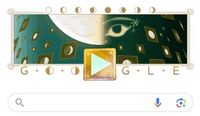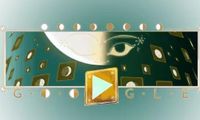NEW DELHI: Tech giant Google has introduced an interactive Doodle to celebrate March’s final Half Moon, engaging users in a celestial card game aimed at testing their knowledge of the lunar cycle. This novel Doodle, launched on March 19, 2025, reflects the natural transitions in the lunar calendar, presenting a fun way for players to connect with astronomy.
The interactive Google Doodle features a card-matching game where users compete against the Moon. In this challenge, players must match different phases of the lunar cycle to earn points. "This interactive Doodle celebrates March’s final Half Moon! This monthly recurring card game invites you to play against the Moon to test your knowledge of the lunar cycle," Google stated in a blog post. By participating, players not only enjoy a game but also learn more about lunar phases.
The gameplay is straightforward yet engaging: users must connect different lunar phases to score points. As players progress, the game becomes more challenging, unlocking four new wild cards along the way. For those who succeed in this celestial contest, Google has designed unique rewards to celebrate their victories. Moreover, players are encouraged to share their high scores with friends, adding a competitive edge to the experience.
As players immerse themselves in the Doodle, they also partake in a greater appreciation of March’s astronomical events. March is commonly referred to as the month of the Worm Moon, a name that signifies the thawing of the winter ground and the return of insects. This transition marks a pivotal change in the environment, as winter gives way to spring.
On March 14, 2025, another significant event occurred—a total lunar eclipse, also known as a "Blood Moon." During this phenomenon, the Moon appeared reddish against the night sky, marking it as an unforgettable sight for stargazers. At that time, the Moon was in its last quarter phase, appearing half-lit. This celestial showcase captured the attention of many, aligning with the educational goals of Google’s Doodle.
Looking ahead, March 20, 2025, will bring the Spring Equinox, which heralds the official start of spring in the Northern Hemisphere. This significant date marks the shortest day length for northern dwellers, while those in the Southern Hemisphere will enjoy the year's longest day. As NASA notes, “As winter in the Northern Hemisphere ends and spring begins, the daily periods of sunlight continue to lengthen, changing fastest around the vernal (spring) equinox on March 20.” The Doodle and these celestial events together provide an opportunity for reflection and learning about one's environment.
Google's Doodle game highlights the importance of community interaction and education. Players can share their results and challenge friends, opening avenues for friendly competition rooted in knowledge about the Moon and its cycles. Indeed, the challenge presented by matching lunar phases overshadows the competition itself, guiding players to develop a better understanding of lunar phenomena.
This innovative Doodle offers a unique blend of entertainment and education, fostering a love for astronomy and the celestial wonders that surround us. As users navigate through lunar cycles in a game format, they also reinforce the natural relationship of these phases to earthly experiences, such as seasonal changes.
In conclusion, whether players are facing-off against the Moon in a digital card game or simply gazing at the night sky, Google’s interactive Doodle encourages a deeper exploration of our universe. By embracing the Moon and all its phases, users not only celebrate March’s final Half Moon but also partake in a broader appreciation of the celestial events that enrich our lives.





